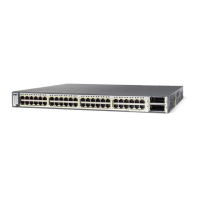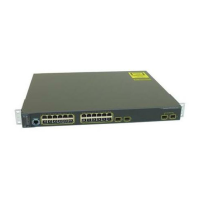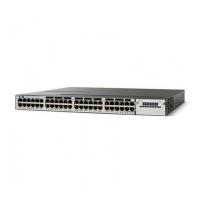42-58
Catalyst 3750-X and 3560-X Switch Software Configuration Guide
OL-21521-01
Chapter 42 Configuring IP Unicast Routing
Configuring BGP
Configuring BGP Neighbors and Peer Groups
Often many BGP neighbors are configured with the same update policies (that is, the same outbound
route maps, distribute lists, filter lists, update source, and so on). Neighbors with the same update
policies can be grouped into peer groups to simplify configuration and to make updating more efficient.
When you have configured many peers, we recommend this approach.
To configure a BGP peer group, you create the peer group, assign options to the peer group, and add
n
eighbors as peer group members. You configure the peer group by using the neighbor router
configuration commands. By default, peer group members inherit all the configuration options of the
peer group, including the remote-as (if configured), version, update-source, out-route-map,
out-filter-list, out-dist-list, minimum-advertisement-interval, and next-hop-self. All peer group members
also inherit changes made to the peer group. Members can also be configured to override the options that
do not affect outbound updates.
To assign configuration options to an individual neighbor, specify any of these router configuration
command
s by using the neighbor IP address. To assign the options to a peer group, specify any of the
commands by using the peer group name. You can disable a BGP peer or peer group without removing
all the configuration information by using the neighbor shutdown router configuration command.
Beginning in privileged EXEC mode, use these commands to configure BGP peers:
Step 5
set comm-list list-num delete (Optional) Remove communities from the community attribute of an
inbound or outbound update that match a standard or extended
community list specified by a route map.
Step 6
exit Return to global configuration mode.
Step 7
ip bgp-community new-format (Optional) Display and parse BGP communities in the format AA:NN.
A BGP community is displayed in a two-part format 2 bytes long. The
Ci
sco default community format is in the format NNAA. In the most
recent RFC for BGP, a community takes the form AA:NN, where the
first part is the AS number and the second part is a 2-byte number.
Step 8
end Return to privileged EXEC mode.
Step 9
show ip bgp community Verify the configuration.
Step 10
copy running-config startup-config (Optional) Save your entries in the configuration file.
Command Purpose
Command Purpose
Step 1
configure terminal Enter global configuration mode.
Step 2
router bgp autonomous-system Enter BGP router configuration mode.
Step 3
neighbor peer-group-name peer-group Create a BGP peer group.
Step 4
neighbor ip-address peer-group
peer-group-name
Make a BGP neighbor a member of the peer group.
Step 5
neighbor {ip-address | peer-group-name}
remote-as number
Specify a BGP neighbor. If a peer group is not configured with a
remote-as number, use this command to create peer groups
containing EBGP neighbors. The range is 1 to 65535.
Step 6
neighbor {ip-address | peer-group-name}
description text
(Optional) Associate a description with a neighbor.
